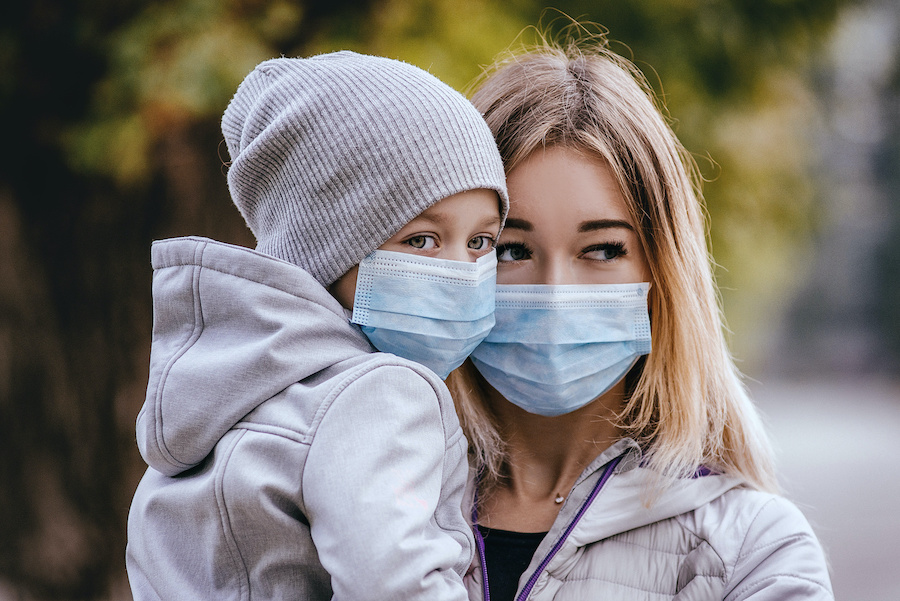
Updated January 25, 2022
Coping with Omicron When You Have a Kid Under 5
For the families of young children, the start of 2022 has mostly not been great. If you’re lucky, maybe your kid has been extra cute lately. Maybe they took their first steps or have struck up an adorable friendship with your pet. But increased cases of the Omicron variant have been especially hard on the families of children under 5, who cannot be vaccinated against COVID-19. With COVID cases in New Mexico as high as they have ever been, families have a lot on their minds.
To help families navigate this tough stretch of the pandemic, we spoke with Dr. Janis Gonzales, who is a pediatrician and New Mexico’s Chief Health Officer for early childhood.
First of all, she says, the struggle is real. That ball of worry that lives in your chest right now? It’s not just you. Parents of young children all over the country are dealing with exposures and quarantines that disrupt their child care, and the anxiety of having unvaccinated children while case counts are soaring but most things are open. More children have COVID than at any other time in the pandemic, largely because the omicron variant is much more infectious than past variants.
So, what should you do? Dr. Gonzales recommends going back to COVID basics. She said the same techniques we have been using to protect ourselves from other variants also work here: Wear a mask, limit your exposure to crowded places, wash your hands, and ensure your child is surrounded by vaccinated people. Dr. Gonzales said this last one is especially important.
“The best way to protect kids actually right now is just to surround them with vaccinated people,” she said. Although breakthrough cases are happening, vaccinated people are less likely to get infected and spread the virus, especially if they have their booster shot. “It adds a layer of protection,” she said.
Layers are key to how Dr. Gonzales thinks about protecting young children. Each protective choice you make helps keep your child or baby a little bit safer.
“I always like to talk about the layers. Almost like with a mask, the more layers it has the better, and … vaccinating people around them is one of those layers. Vaccinating, masking, not going to crowded indoor places.”
Does all this talk about layers make you think about ogres and/or onions? Do you need to go watch Shrek while you sob loudly and remember a simpler time in your life? Go ahead, we’ll wait.
OK, you’re back. Let’s talk about masks. You may have read that public health experts are recommending people switch from cloth masks to medical ones like N95 or KN95 masks. The government doesn’t certify these types of masks for kids, but there are companies making medical-quality masks for smaller faces. Unfortunately these masks are hard to find right now, and it can be tough to know whether you’re ordering a mask that is legitimate and will fit your child’s face when it arrives.
So, what should you do? Dr. Gonzales said it’s worth trying to find a medical mask for your child if you can, since science shows these masks do a better job of protecting us from the omicron variant. But don’t sacrifice fit in the name of a medical mask. If you’re choosing between a three-ply medical mask that constantly falls over your child’s nose, versus their two-layer cloth mask that fits them well and stays in place, consider sticking with the cloth.
“Wear the best mask you can find that will fit,” said Dr. Gonzales. Although cloth masks are less protective, she said the best mask for your child is the one they will wear all day.
If you’re inspired to upgrade your child’s mask but aren’t sure where to start, you can try here, here or here for some legitimate places where you’re less likely to find scammers and low-quality masks. If this seems like an overwhelming thing to have to figure out after a long day of caregiving, you’re not wrong.
Feeling overwhelmed is a natural response to this time, and it’s important to know you aren’t alone. New Mexico has resources to help families with young children, including home visiting for families with or expecting new babies, help paying for child care, and more. Remember that pandemic parenting stress is (still) normal, and check out our past tips for coping with it.
If it helps, try to remember that this moment isn’t forever. Experts don’t know what will happen next in this pandemic, but the omicron variant tends to move quickly. In states and countries where omicron arrived earlier than New Mexico, it tends to create a steep wave of cases that passes fairly rapidly. Some experts think New Mexico’s omicron wave will peak by early February, and then start to go back down.
Until then, take care of yourself. Try Wordle. Eat some chiles. And be kind to others. With so many people struggling, tempers can run hot. Try to bring your best patience and grace to dealing with others, even if you’re bubbling over with two years of pent-up screaming.
“We all need to be kind and patient and know that we’re all struggling, really,” said Dr. Gonzales. “Teachers are struggling, families are struggling, the people trying to run the programs are struggling, everybody. So, maybe just having that extra little bit of patience and kindness.” And that means for yourself, too.

Did you find this article helpful?
Subscribe to Bright By Text to get more free tips and resources for your child’s journey, right to your phone!
